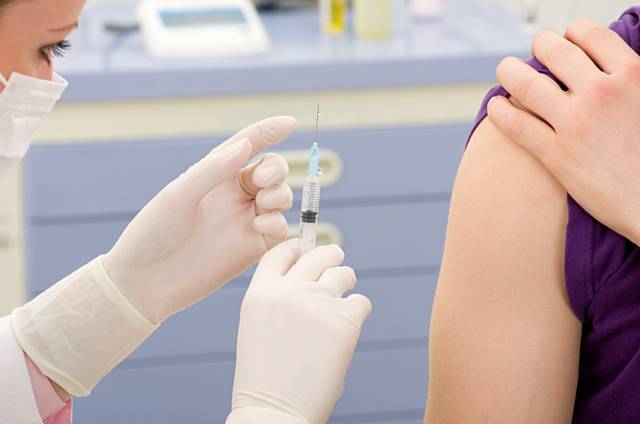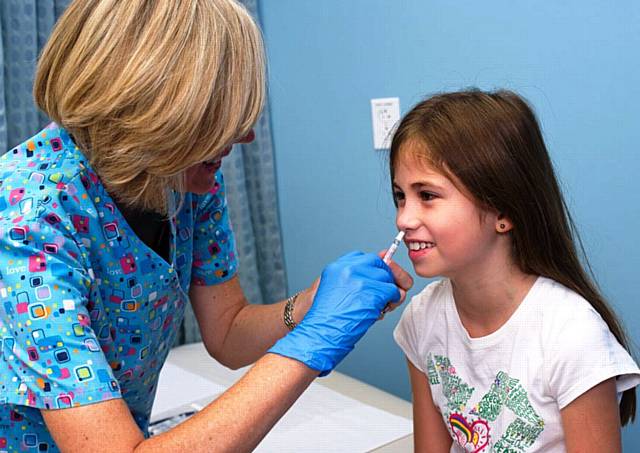Fewer vulnerable people opting for free flu jab
Date published: 01 September 2020

The take-up rate amongst those in vulnerable groups eligible for a free vaccine has declined
Fewer people eligible for a free flu vaccination are taking it, new analysis by the BBC Shared Data Unit has found.
The take-up rate amongst those in vulnerable groups eligible for a free vaccine has declined.
Charities and academics believe legitimate concerns around the side effects of vaccines, religious barriers and a “complacency” around the effects of flu are putting people off taking it.
And they say there is a particular problem among people under 65 with serious health conditions such as asthma and Multiple Sclerosis, where uptake is “worrying”.
The government wants to double to number of people vaccinated from 15 million to 30 million in order to reduce pressure on the NHS this winter.
Other experts say the government has failed to deliver an effective strategy in recent years - leaving it currently languishing below World Health Organisation-set targets.
While the uptake of the vaccine has remained steady among the over 65s - among the at-risk under 65s, rates are languishing well below World Health Organisation (WHO) set guidelines in recent years. The WHO says countries should aim for 75%.
Furthermore, the government is aiming for a “universal” uptake of the flu vaccine among healthcare professionals – but only half of staff in some parts of the NHS took the jab during the last season.
Addressing the importance of being vaccinated against flu this year, director of the Vaccine Confidence Project, Professor Heidi Larson said: “I think it’s pretty important this year because what the UK wouldn’t want is cases of people catching both flu and Covid-19. Both attack the respiratory system but Covid attacks a lot more organs than just the lungs. You wouldn’t want that double attack on the system.
“I find there is almost a complacency around the vaccine in the UK.
“It doesn’t have the same aggressive ‘anti’ sentiment we see against some of the childhood vaccines.”
Professor Wendy Barclay, head of the department of infectious diseases at Imperial College London, added: “Generally speaking, if people are not getting vaccinated, they are not as protected.
“The vaccine is not a virus; it cannot make you ill. It might make you tired but that means it is working. When you feel achy, it is nothing like having the flu, but it does mean the vaccine is working. I would be more worried if you didn’t feel anything.”
Vulnerable under-65s
Among under 65s in the at-risk group, figures from the last winter flu season show local authorities averaged only a 45% take-up. This figure was highest in the North West, with 47.6%.
Over the past five years, the rate has been falling in England. In 2015, the average was six percentage points higher at 51%. Locally for the same time period, this figure has fallen from 58.1% to just 51.2% in the Rochdale borough.
Just two local authorities hit the NHS’s lower target of 55% - Stockport and West Berkshire – and only five local authorities have managed to increase the uptake among under 65s over the last five years.

Schools
School vaccination has been expanding - last year it was introduced to year six pupils for the first time. Nursery school children aged two and three have been vaccinated for several years in England, but only a quarter of authorities are meeting the 50% vaccination rate ambition set by the government.
However, take-up is still below the government’s target of vaccinating 65% in the majority of local authority areas in England. Just 59 of 152 authorities who responded to the government survey reached 65% overall.
Take-up by age-group was highest for reception and lowest for Year 6, with just 28 authorities achieving vaccination over 65% in that group.
In Greater Manchester, the average uptake of children receiving the flu jab at primary school age was 61.5%.
Professor Barclay said: “There is a fantastic piece of epidemiology that found the number of flu cases rose until July when the schools broke up and it went away.
“Young children can get very sick themselves and they have a much heavier infection and are much more likely to pass it on to someone else.
“Those children interacting among other children are passing it on to other children. They are not likely to get very ill or die but they get home and see granny and grandad and can pass it on to them.
“I think parents don’t know this. If the message isn’t strong enough, parents think: ‘It’s only the flu, my kids will be fine’.”
Professor Larson added: “Part of the nasal vaccine for children contains traces of porcine gelatin, which has prevented many Muslim parents from taking it up.
“There are also people that say it doesn’t work enough, it’s not effective enough. Some of these concerns aren’t wrong.
“Some years it really isn’t that effective against all strains. But I would certainly urge people to take it anyway as you wouldn’t want the strains that it does protect against.”
Healthcare workers
The uptake rate of the vaccine among healthcare workers in England has been improving over the past five years.
During the 2015-16 flu season, 51.2% of all frontline health workers, including doctors and nurses, took up the vaccine.
In 2019-20, that had risen to 75.7%. Only seven trusts saw their vaccination rate decline among staff between 2015 and 2020.
However, in 2019-20, there were large disparities across the English trusts, some of which saw uptake levels remain below 50%.
Pennine Care NHS Foundation Trust had the lowest uptake rate in England at 44.8% - whilst neighbouring East Lancashire Hospitals NHS Trust had the highest in England with 94.3% uptake.
There are also smaller disparities in take-up between the types of clinicians in 2019-20.
The lowest average take-up is among qualified nurses: 73.2%.
Clare Parker, director of nursing, healthcare professionals and quality governance at Pennine Care NHS Foundation Trust, said: “We were really disappointed with our flu vaccine uptake last year, as we know how important this is to help keep people safe.
“We face the challenge of vaccinating staff working on over 100 different sites across a large region, and also who are totally focussed on delivering mental health and learning disability services. But this does not excuse the fact that we need to do much better and we are working hard to improve our vaccination programme.
“We’re putting stronger systems and processes in place to make sure the vaccine is available to staff as early and easily as possible, whilst we adhere to strict Covid guidelines. “We’re also promoting the responsibility that everyone has to help keep themselves, patients, families and carers safe by having the vaccine, along with myth busting.
“It’ll be interesting to see the impact of Covid on the flu vaccination programme this year, as both are respiratory diseases that place the elderly and chronically ill at particular risk. By any rational viewpoint, convincing people to get a flu vaccine shouldn’t be a challenge, but we know that we need to emphasise that the lethality and spread of Covid does not minimise the very real dangers of flu.”
Eligibility
Up until this year, the vaccine was eligible to those who were 65 years old or over, pregnant, under 65 with underlying medical conditions, living in a long-stay residential care home or other similar facility, or those receiving a carer’s allowance or who are the main carer for an elderly or disabled person whose welfare may be at risk if they fall ill.
However the government has decided to expand those eligible to receive it in 2020-21.
The vaccinations will be delivered in two stages.
Stage one will see a free flu vaccine made available to people who are on the shielded patient list and members of their household as well as:
- All school year groups up to year 7
- All people aged over 65
- Pregnant women
- Under 65s with pre-existing conditions including at-risk under two
The government says that once vaccination of the most ‘at-risk’ groups is under way, the department will work with clinicians to decide when to open the programme to invite people aged 50 to 64, with further details to be announced.
Dr Tonia Thomas, vaccine knowledge project manager at the Vaccine Knowledge Trust, which is part of the University of Oxford, said: “It is useful to think about the clinical risk groups that are covered.
“We have gone from the mild end, such as someone with asthma that hasn’t needed medication for many years and is very healthy, but on the other end of the spectrum there is someone with a neurological condition who is in and out of hospital a lot.
“There is a big spectrum of people that fall into the risk category.”
Those in clinical risk groups include those with medical conditions such as multiple sclerosis, asthma, and those with weak immune systems. The flu can be particularly bad for these individuals, making their existing conditions much more serious. They are also most at risk of suffering from life-threatening forms of the Covid-19 virus.
The NHS will contact people directly, including information about where to go to get the vaccine.
Do you have a story for us?
Let us know by emailing news@rochdaleonline.co.uk
All contact will be treated in confidence.
Most Viewed News Stories
- 1Rochdale Online Ltd has ceased trading
- 2The land has laid dormant for years, now £15m could help see it transformed
- 3Back of The Moss Community Centre hosts Alzheimer’s Society singing sessions
- 4Middleton Band triumphs at 2025 North West Regional Championships
- 5Man killed in M62 crash after car hits bridge at junction 19
To contact the Rochdale Online news desk, email news@rochdaleonline.co.uk or visit our news submission page.
To get the latest news on your desktop or mobile, follow Rochdale Online on Twitter and Facebook.

